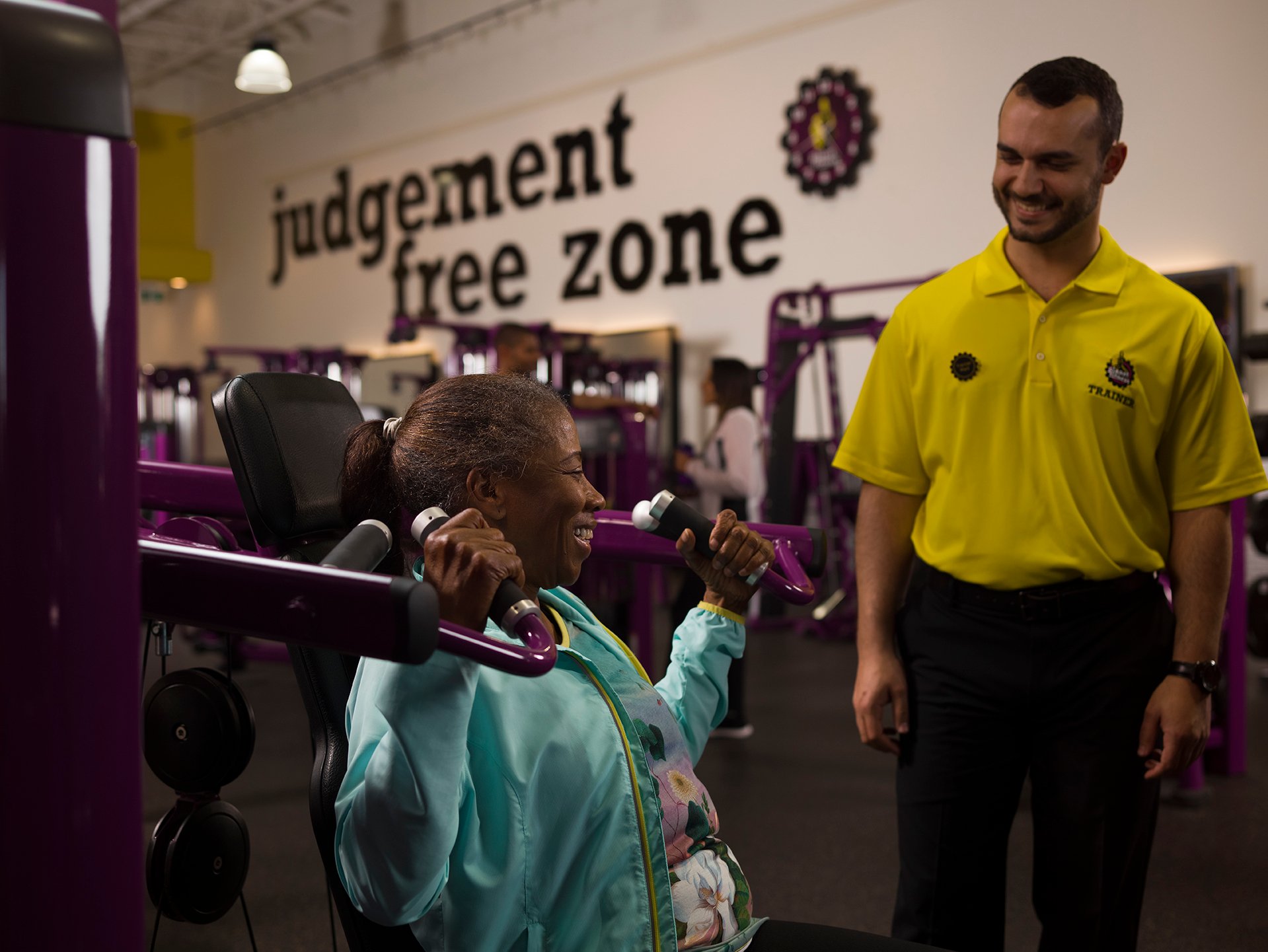

Featured
What Is Reps In Exercise
Published: September 27, 2023
Learn what reps are and how they play a crucial role in exercise routines. Discover the benefits of incorporating featured reps into your workouts for optimal fitness results.
Introduction
Welcome to the world of fitness and exercise! If you’ve ever stepped foot in a gym or participated in any sort of physical training, you’ve probably heard the term “reps” being thrown around. But what exactly are reps, and why are they such an essential part of any exercise routine? In this article, we will explore the definition of reps, their significance in achieving fitness goals, the different types of reps, and how to effectively perform them.
Reps, short for repetitions, are a fundamental unit of measurement in the world of exercise. They refer to the number of times you perform a specific movement or exercise in a set. For example, if you do 10 push-ups in a row, you have completed 10 reps of push-ups. Repetitions play a crucial role in building strength, endurance, and muscle hypertrophy.
Understanding the importance of reps in your workout routine is vital to achieving your fitness goals. Whether you’re an athlete aiming to enhance performance, a bodybuilder looking to increase muscle mass, or simply someone trying to stay fit and healthy, reps are a key component of your training regimen.
Before we delve deeper into the world of reps, let’s discuss the different types of repetitions that exist. This knowledge will help you tailor your workouts to suit your specific objectives and maximize your results. So, are you ready to dive into the world of reps and take your fitness journey to new levels? Let’s get started!
Definition of Reps
Reps, or repetitions, are a fundamental concept in exercise and fitness. They refer to the number of times a specific movement or exercise is performed consecutively within a set. For example, if you perform 10 consecutive bicep curls, you have completed 10 reps of bicep curls.
Reps are an essential metric used to track and quantify the intensity and workload of a workout. They play a vital role in achieving various fitness goals, including increasing strength, building muscle mass, improving endurance, and enhancing overall physical performance.
The number of reps performed in a set can vary depending on factors such as fitness level, exercise type, and individual goals. Generally, reps can range from as low as 1 to as high as 20 or more. The optimal rep range for an individual depends on their specific objectives and the type of exercise being performed.
Reps are often combined with another critical component of exercise, known as sets. A set refers to a group of repetitions performed consecutively without rest. For example, if you perform 3 sets of 12 reps of squats, it means you complete 12 squats, rest for a brief period, and repeat the cycle two more times.
By manipulating the number of reps and sets, individuals can tailor their workouts to target specific muscle groups, improve muscular endurance, or focus on maximizing strength and hypertrophy.
Overall, understanding the definition of reps is essential for anyone embarking on a fitness journey. They provide structure and organization to workouts and allow individuals to track progress, set goals, and continuously challenge themselves. So, whether you’re a beginner or an experienced fitness enthusiast, reps are a vital component of any exercise routine.
Importance of Repetitions in Exercise
Repetitions, or reps, are a fundamental aspect of exercise that hold immense importance in achieving your fitness goals. Whether you’re aiming to build strength, increase muscle mass, improve endurance, or enhance your overall physical performance, understanding the significance of reps is crucial. Let’s delve into why repetitions are so vital in your exercise routine.
First and foremost, reps allow you to effectively challenge and stress your muscles, which is essential for inducing physiological adaptations. When you perform exercises with a specific number of reps, you are subjecting your muscles to a targeted stimulus, causing them to contract and exert force repeatedly. This repetitive stress helps break down muscle fibers and triggers the process of muscle rebuilding and growth.
Furthermore, reps provide a measurable metric for tracking progress and objectively evaluating your performance. By keeping track of the number of reps you can perform in a given exercise, you can gauge your strength, endurance, and improvement over time. Monitoring progress is not only motivating but also helps you set realistic goals and tailor your training program accordingly.
Repetitions also play a crucial role in enhancing muscular endurance. As you perform higher numbers of reps with a specific exercise, your muscles adapt by developing increased endurance capabilities. This endurance-building aspect of reps is particularly valuable for athletes who need to sustain muscular effort for extended periods, such as runners, swimmers, and cyclists.
In addition to the physical benefits, reps also contribute to mental development and discipline. Pushing through a challenging set of repetitions requires mental focus, determination, and mindset. Over time, consistently performing reps with proper form and intensity can enhance mental resilience and discipline, which can positively impact other areas of your life.
Moreover, reps allow for progressive overload, a principle that is crucial for continued progress in your fitness journey. Gradually increasing the number of reps or the resistance used in an exercise challenges your muscles to adapt and grow stronger. Without progressive overload, your muscles may plateau, and your progress will stagnate.
Overall, understanding the importance of repetitions in your exercise routine is essential for achieving your fitness goals. By incorporating the right number of reps with proper form and intensity, you can enhance muscle growth, improve endurance, track progress, and develop mental resilience. So, embrace the power of repetitions and take your workouts to the next level!
Types of Reps
When it comes to reps in exercise, there are different types that you can incorporate into your training routine. These variations in repetition techniques can target specific muscle groups, enhance muscle development, and improve overall strength and endurance. Let’s explore some common types of reps:
- Standard Reps: Standard reps, also known as regular reps, are the most common type. In this approach, you perform a movement or exercise for a specific number of repetitions, usually in a controlled and consistent manner. For example, completing 10 reps of squats, focusing on maintaining proper form throughout.
- Eccentric Reps: Eccentric reps involve focusing on the lowering or lengthening phase of an exercise. This type of rep emphasizes controlled and slow movements while lengthening the targeted muscle. For instance, during a bicep curl, you would lower the dumbbell slowly and with control, emphasizing the eccentric contraction of the bicep muscle.
- Paused Reps: Paused reps involve inserting a brief pause or hold at a specific point during an exercise. This pause increases time under tension, which intensifies the contraction and creates more muscle fiber recruitment. For example, during a bench press, you may pause for 2 seconds with the barbell just above your chest before completing your next rep.
- Drop Reps: Drop reps, also known as strip sets or descending reps, involve reducing the resistance or weight after reaching muscle fatigue. This technique allows you to push past failure and continue the exercise with a lighter load. For instance, you may start with a heavy weight for 8 reps, then immediately decrease the weight and continue with another 8 reps.
- Pyramid Reps: Pyramid reps involve gradually increasing or decreasing the weight for each set of an exercise. This technique can be performed in an ascending or descending manner. For example, starting with a lighter weight for higher reps, then gradually increasing the weight while decreasing the number of reps as you progress through each set.
- Negative Reps: Negative reps, also known as eccentric-focused reps, involve placing more emphasis on the lowering or negative phase of an exercise. This technique involves using a weight that is heavier than your usual load and focusing on controlling the descent. For example, during a pull-up, you may use a chair or assistance to reach the top position, then slowly lower yourself down in a controlled manner.
- Rest Pause Reps: Rest pause reps involve taking a short rest or pause between each repetition within a set. This technique allows you to perform additional reps beyond what you would typically be able to do in a continuous set. For instance, during a set of push-ups, you may perform 5 reps, pause for 10 seconds, and then complete another 5 reps.
Each type of rep variation offers unique benefits and challenges to your training. By incorporating different types of reps into your workouts, you can target different muscle fibers, break plateaus, and add variety to your routine. Remember to choose the types of reps that align with your goals and consult with a fitness professional if needed. So, don’t be afraid to switch up your rep schemes and explore the different variations to maximize your results.
Determining the Ideal Rep Range
Choosing the right rep range for your workouts is crucial for achieving your fitness goals. The ideal rep range will vary depending on factors such as your training objectives, fitness level, and the specific exercise you are performing. Understanding how to determine the right rep range for your workouts is essential for optimizing your results. Let’s explore some factors to consider when finding your ideal rep range:
Training Goals: Different rep ranges have different effects on the body. If your goal is to build strength and increase power, focusing on lower reps with heavier weights is ideal. In contrast, if you’re aiming for muscle hypertrophy or endurance, higher reps with moderate weights may be more effective. Consider your goals and align your rep range accordingly.
Exercise Type: The nature of the exercise also plays a role in determining the appropriate rep range. Compound exercises, which involve multiple muscle groups, generally benefit from lower rep ranges, as they require more strength and power. Isolation exercises, which target specific muscle groups, can be performed with higher reps to induce hypertrophy and endurance.
Fitness Level: Your fitness level is another factor to consider. Beginners should start with a moderate rep range to develop proper form and technique while minimizing the risk of injury. As your strength and endurance increase, you can gradually progress to heavier weights and lower rep ranges. Advanced individuals may require higher intensity with lower reps to further challenge their muscles.
Progression and Adaptation: It’s important to continuously challenge your muscles to promote growth and adaptation. Consider incorporating progression techniques, such as increasing weight, decreasing rest times, or changing rep ranges periodically. This helps break plateaus and ensures consistent improvements over time.
Time Under Tension: Time under tension (TUT) refers to the total duration your muscles are actively working during a set. Longer time under tension, achieved through higher rep ranges with slower tempos, can stimulate muscle hypertrophy and endurance. Shorter time under tension, achieved through lower rep ranges with explosive movements, is more effective for power development and strength gains.
Listen to Your Body: Ultimately, the ideal rep range for you is one that challenges you while still allowing you to maintain proper form and technique. Pay attention to how your muscles feel during and after workouts. If you consistently struggle to complete the desired rep range with good form, it may be too heavy. Conversely, if you can easily perform the desired reps without feeling challenged, it may be too light.
Experimentation is key when determining the ideal rep range for your workouts. Don’t be afraid to try different rep ranges and observe how your body responds. Consulting with a fitness professional or personal trainer can also provide valuable guidance and help tailor your rep range based on your individual needs and goals. Remember, finding the right rep range will optimize your training and enable you to achieve the desired outcomes.
How to Perform Reps Effectively
Performing reps effectively is vital to maximize the benefits of your exercise routine. Proper form, technique, and execution contribute to optimal muscle activation, minimize the risk of injury, and help you achieve your desired fitness goals. Here are some tips to perform reps effectively:
- Maintain Proper Form: Before focusing on the number of reps, ensure that you are performing the exercise with correct form. This includes maintaining proper posture, aligning joints correctly, and engaging the target muscles throughout the movement. Proper form ensures that you are targeting the intended muscle groups and reduces the risk of strains or injuries.
- Breathe Properly: Breathing is often overlooked, but it plays a crucial role in exercise performance. Remember to inhale during the relaxation or eccentric phase of the exercise and exhale during the contraction or concentric phase. Proper breathing helps stabilize your core, enhance oxygen flow, and maintain proper ribcage positioning.
- Control the Movement: Performing reps with control is key to effective execution. Avoid using momentum or relying on external forces to complete the movement. Instead, focus on a slow and controlled tempo, emphasizing the muscle contractions throughout the entire range of motion. This allows for maximum muscle recruitment and engagement.
- Focus on Mind-Muscle Connection: Develop a strong mind-muscle connection by consciously engaging and contracting the target muscles during each rep. Visualize the muscle working and concentrate on feeling the muscle fibers stretch and contract. This mental focus enhances muscular activation and can lead to better results.
- Use a Full Range of Motion: When performing reps, aim to utilize a full range of motion for each exercise. This means fully extending and flexing the joints involved. Performing partial reps limits the effectiveness of the exercise and may lead to muscle imbalances. However, be sure to maintain control and avoid joint hyperextension or excessive range of motion that compromises form or stability.
- Progress Gradually: Gradually increase the intensity of your reps over time. Start with a weight or resistance level that allows you to perform the desired number of reps with proper form. As you become comfortable and stronger, gradually increase the resistance or the difficulty of the exercise. This progressive overload stimulates muscle growth and prevents plateauing.
- Rest and Recovery: Give your muscles sufficient time to recover between sets and workouts. Proper rest allows your muscles to repair and adapt to the stress of exercise. Rest times between sets can vary depending on your goals and the rep range you are using. Resting too little can compromise performance, while resting too long can reduce the overall effectiveness of the workout.
Remember, quality is far more important than quantity when it comes to performing reps effectively. Prioritize proper form, control, and mind-muscle connection. It’s better to perform fewer reps with excellent technique than to rush through a set with compromised form. With time, practice, and patience, performing reps effectively will become second nature, leading to better results and reducing the risk of injury.
Common Mistakes to Avoid with Reps
While incorporating reps into your exercise routine is beneficial, it’s essential to be aware of common mistakes that can hinder your progress and potentially lead to injuries. By understanding and avoiding these mistakes, you can ensure that your reps are performed effectively and safely. Let’s take a look at some common mistakes to avoid:
- Using Poor Form: One of the biggest mistakes people make is sacrificing proper form for the sake of completing more reps or lifting heavier weights. Poor form reduces the effectiveness of the exercise and increases the risk of injury. Always prioritize maintaining correct posture, positioning, and alignment throughout the entire range of motion.
- Overtraining: Overtraining occurs when you exceed your body’s capacity to recover from exercise. This can happen by performing too many reps, sets, or workouts without adequate rest and recovery. Overtraining can lead to decreased performance, fatigue, and an increased risk of injury. Listen to your body, incorporate rest days into your routine, and give yourself time to recover between workouts.
- Not Breathing Properly: Many people forget the importance of proper breathing during reps. Improper breathing can lead to decreased core stability, reduced oxygen intake, and overall diminished exercise performance. Remember to inhale during the relaxing phase and exhale during the exertion phase of each rep to maintain optimal breathing patterns.
- Rushing Through Reps: It’s common to get caught up in completing a certain number of reps quickly. However, rushing through the movement sacrifices control and effectiveness. Ensure that each rep is performed with a controlled tempo, emphasizing the muscle contractions and focusing on the mind-muscle connection. Quality and control should always take precedence over quantity.
- Neglecting Proper Warm-up: Neglecting a proper warm-up is a mistake that can lead to muscle strains, sprains, and decreased performance during reps. A warm-up should include dynamic stretching, mobility exercises, and light aerobic activities to increase blood flow and prepare the muscles for the upcoming exercises. Dedicate sufficient time to warm up before diving into your reps.
- Ignoring Progression: Failing to progress your rep range, resistance, or intensity can hinder your progress over time. Your body quickly adapts to the same stimulus, so it’s essential to challenge yourself by gradually increasing the difficulty of your workouts. Incorporate progression techniques such as adding weight, decreasing rest times, or changing the rep range to create new challenges and continually push your limits.
- Not Listening to Your Body: Every individual is unique, and what works for one person may not work for another. Pay attention to your body and adjust your rep range and intensity accordingly. Pushing through excessive fatigue, pain, or discomfort can lead to injuries. Give yourself permission to modify the rep range or take breaks when needed.
Avoiding these common mistakes will help you get the most out of your reps, optimize your performance, and reduce the risk of injuries. Remember, always prioritize proper form, progression, and listen to your body. By doing so, you will enhance the benefits of your workouts and achieve better results in the long run.
Benefits of Incorporating Reps into Your Workout Routine
Incorporating reps into your workout routine offers a multitude of benefits that can help you achieve your fitness goals and improve overall physical performance. Whether you’re looking to build strength, increase muscle mass, enhance endurance, or simply maintain a healthy lifestyle, here are some key benefits of incorporating reps into your workouts:
- Strength Development: Performing reps with appropriate resistance stimulates the muscles, leading to strength development. As you consistently challenge your muscles with progressively heavier weights or resistance, they adapt and become stronger over time. Regularly incorporating reps into your workouts helps improve overall strength, making everyday activities easier and enhancing athletic performance.
- Muscle Hypertrophy: Reps play a crucial role in muscle hypertrophy, which refers to the increase in muscle size. By subjecting your muscles to the stress of repetitive contractions, you create microscopic damage to the muscle fibers. With proper nutrition and rest, these damaged fibers are repaired and grow stronger and larger as a result. If your goal is to increase muscle size, incorporating a higher rep range can be particularly effective.
- Endurance Improvement: High-rep training improves muscular endurance. By performing a higher number of reps with lighter weights, you challenge your muscles to sustain effort over an extended period. This type of training increases the muscles’ ability to resist fatigue and perform repetitive tasks for longer durations, making it highly beneficial for athletes participating in endurance-based activities.
- Metabolic Boost: Rep-based workouts increase your metabolic rate, leading to a greater calorie burn both during and after your exercise session. The continuous muscle contractions and higher intensity of reps elicit an elevated metabolic response, promoting fat loss and improving body composition. As a result, incorporating reps into your workout routine can aid in weight management and contribute to a more efficient metabolism.
- Improved Bone Density: Weight-bearing exercises that involve reps, such as strength training, have been shown to improve bone density. The repeated load and impact on the bones during reps stimulate bone remodeling, leading to increased bone mineral density. Incorporating reps into your workouts helps strengthen your bones, reducing the risk of osteoporosis and fractures.
- Enhanced Mental Resilience: Performing reps requires mental focus, determination, and discipline. Pushing through challenging sets helps develop mental resilience, persistence, and the ability to overcome obstacles. These mental benefits extend beyond the gym and can positively impact other areas of your life, improving your ability to tackle challenges and stay focused on your goals.
- Increased Cardiovascular Fitness: Rep-based workouts can provide a cardiovascular workout, especially when combining multiple exercises in a circuit or performing reps in a faster tempo. This cardiovascular component increases heart rate, improves circulation, and enhances cardiovascular fitness. Incorporating reps into your routine helps strengthen both your muscles and your cardiovascular system.
These are just a few examples of the many benefits of incorporating reps into your workout routine. Whether you prioritize strength, muscle growth, endurance, or overall fitness, incorporating reps can help you achieve your desired outcomes while improving your overall health and well-being. Embrace the power of reps and make them a foundational element of your exercise regimen.
Conclusion
Reps, or repetitions, are a cornerstone of any effective exercise routine. They provide structure, measurement, and progression to your workouts, whether you’re aiming to build strength, increase muscle mass, improve endurance, or enhance overall physical performance.
Understanding the definition, types, and importance of reps allows you to tailor your workouts to suit your personal goals and needs. By maintaining proper form, focusing on technique, and gradually increasing the intensity, you can perform reps effectively, maximize muscle activation, and reduce the risk of injury.
Incorporating reps into your workout routine offers a variety of benefits. From developing strength and muscle mass to improving endurance and cardiovascular fitness, reps play a vital role in achieving your fitness goals. Additionally, they contribute to enhanced mental resilience, increased bone density, and a boosted metabolic rate.
Remember to determine the ideal rep range based on your goals, fitness level, and exercise type. Progression, listening to your body, and incorporating rest and recovery are key principles to consider when performing reps effectively.
Embrace the power of reps and make them an integral part of your fitness journey. With consistency, proper technique, and a commitment to your goals, incorporating reps into your workout routine will yield significant improvements in strength, endurance, muscle development, and overall fitness.








